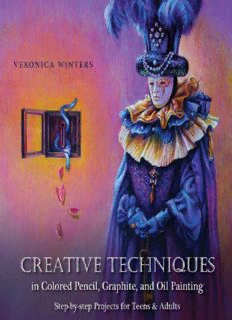
Creative Techniques in Colored Pencil, Graphite, and Oil Painting: Step-by-Step Projects for Teens and Adults PDF
Preview Creative Techniques in Colored Pencil, Graphite, and Oil Painting: Step-by-Step Projects for Teens and Adults
Creative Techniques in Colored Pencil, Graphite, and Oil Painting Step-by-Step Projects For Teens & Adults Download additional demos, videos, books at www.VeronicasArt.com Creatures of the Sea, colored pencil, 7 x 13 in. Copyright © 2013 Veronica Winters All rights reserved under International and Pan-American Copyright Conventions. No portion of this book may be reproduced in any form without the written permission of the publisher, except by a reviewer, who may quote brief passages in connection with a review for a magazine or newspaper. Prismacolor, Turpenoid, General’s, Xerox, Strathmore, and other brands mentioned in this book are registered trademarks. Editor: Dr. Elizabeth Timberlake-Newell Photography and artwork: Veronica Winters Cover design and book layout: Veronica Winters Published in the United States by UltraMax Publishing, LLC Contents About the Artist Introduction Drawing for Study Drawing for inspiration 1 MATERIALS AND MEDIUMS Drawing mediums and tools Graphite, Charcoal, Conté Approaches to shading Making Textures: Rubbing, Indenting, Masking, Erasing Colored Pencil Blending Water-Soluble Colored Pencil Pastel Papers for drawing Textured papers Smooth papers Toned/colored papers Other equipment you need Canvases for painting Acrylic and oil paint Brushes Palette knives Easels Basic colors for oil painting The acrylic vs. oil difference Techniques 2 LIGHT, VALUES, EDGES, SHAPES & SPACE Working with light What is value? Edges Demonstration: Three Cherries Direction 10 big mistakes every student makes Positive & negative space Finding basic shapes in complex objects Demonstration: Lava Lamp Demonstration: Teakettle Demonstration: Still Life with Grapes & Orange 3 COMPOSITION, COLOR & BACKGROUND Compositional Tricks Compositional Formats How to come up with best picture Basic Color Theory Temperature, Intensity & Value Working with Background Space Layering the darks in colored pencil/pastel drawing Layering darks in black-and-white drawing Layering darks in oil/acrylic painting Demonstration: Anemone with a Bud Demonstration: Desert Rose Demonstration: Purple Lily 4 PERSPECTIVE, PROPORTION & REFLECTIONS Perspective Zero-point linear perspective One-point linear perspective Two-point linear perspective Proportion Demonstration: Lotus Chalice Demonstration: Ayutthaya Buddha Reflections in Water How to draw reflections Reflections on objects How to draw reflections Demonstration: Jade Buddha Demonstration: Thai Sunrise 5 CATS & OTHER WILDLIFE Features & techniques General body shape How to make textures/ animal hair Demonstration: Tigress, the kitty Demonstration: Cat Sasha Demonstration: Bastet, the Egyptian cat Demonstration: Tigress, oil painting Demonstration: The Funky Monkey Demonstration: The Giraffe 6 IMAGINATION & FUN PROJECTS Fantasy art painting Paper Collage Creating paper or photo collage Paper collage demonstration Painting your ideas Advanced demonstration: Buddha with Naga Advanced demonstration: Thai Monkey-Demon Glossary Color Chart About the Artist Russian-American fine artist Veronica Winters holds an M.F.A. in painting from Pennsylvania State University and a B.F.A. degree in studio art from Oklahoma State University. She studied classical painting at the Art Students League of New York and the Grand Central Academy of Art in New York. Veronica’s art is found in numerous private collections and her work has been featured in Leisure Painter, American Art Collector, Artists & Illustrators, Colored Pencil Magazine, 2004 & 2013 Women Artists Datebook, and other image-licensed books and magazines. To see Veronica’s paintings, drawings, books, and projects, visit veronicasart.com. Special Thanks: I thank Stelli Munnis and Max Fomitchev for technical support with the book. I’m grateful to Ingrid Lyon, editor of Leisure Painter, who let me use a few of my demonstrations previously printed in the magazine. My heart goes out to all my supporters and friends. I couldn’t have been here today without you! Facing thirty six, self-portrait, colored pencil, 12 x 15 in. Introduction Living as an artist today is so much different from than it was just a couple of centuries back. Contemporary artists have so much freedom in choosing what subjects to paint or when and where to paint them. The Church is not the main customer or commissioner anymore, and artists can explore infinite possibilities in their preferred art form. Women are free to pursue an education in art and are able to achieve a success in the field that was nearly impossible in the past. At the same time creative personalities face a number of other challenges that might not have been so prevalent earlier. Today artists receive various education skill-wise and often lack the consistency, time and proven methods to develop technique. Until late 19-th century artists went through grueling training methods, studying for many years in school, copying plaster casts, drawing and painting from life for many hours each day and working as apprentices to master-artists of the day to eventually become professional, independent artists. Methods in learning the craft of painting had been worked out for centuries in art schools where artists faced thorough training in classical realism. When these rigid educational rules were finally broken, creativity was spurred but the learning process became complicated. Today, many artists consider themselves accomplished without the same solid educational background their predecessors had. Sometimes it is to students’ advantage, however, to study various methods of painting and drawing from different sources and on new terms. Having a variety of approaches and platforms to learning opens up new horizons for everyone. The Internet, YouTube, art magazines and books often feed our curiosity. In addition, education is open for all and we are
Description: